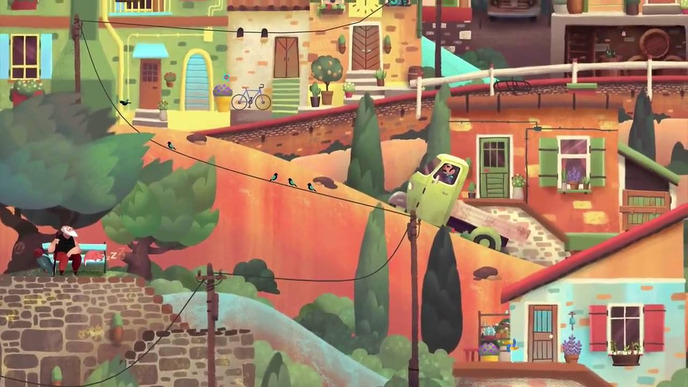
Old Man’s Journey is the latest in a genre I call the “reverse-bildungsroman.” Instead of stories that show a coming-of-age tale filled with youth’s fragility and daring, these are stories of the aged looking back and taking stock. They are often reflective, but also refractive; we see the fragments of a person’s life cobbled together and considered as a whole. But a narrative needs dynamism. Nobody wants to watch a man rock in his chair and read his journal. So this quest through memory is given form. Few games have tackled the feeling; we more often travel backwards in film or literature. (See: The Big Chill,, The Notebook.) The closest comparison to Broken Rule’s newest game is The Straight Story, David Lynch’s surprisingly sweet tale of an old man visiting a sick brother, where we watch as the protagonist travels across great distance on a tractor. In Old Man’s Journey, we lead the titular man as he puts on his walking shoes and ambles forth from his seaside home toward some unknown destination.
Though available on Steam, I played on iPad, and the handheld object proves to be the perfect platform for the contemplative game. It feels like you’re holding the man’s diary given animated life and watching the pages come alive. At first you worry the journey will be all too simple: All you’re tasked with doing is poking your finger on the screen, which drops a waypoint and he scurries off. But very soon you realize the landscape is not conducive to his feeble legs. He needs to follow a path that is high up on a hill above, and his climbing days are long behind him. But experimenting you realize the world is segmented by layers of fore- and background. By holding and swiping, you can control a layer and drag it around, bringing asphalt roads and grassy knolls in contact with our everyman’s path. Once the landscape has been reconfigured, he’s ready and able to walk toward the planted flag.
Broken Rules tend to make games where the player’s movement is central to the game’s conceit. In And Yet It Moves you rotated a labyrinthine cavern around the main character allowing him to move throughout the maze. In Chasing Aurora, you swooped and darted across the sky with the agility and grace of birds. Without the unique sense of control, each would have been pretty versions of other things. But the combination of style, artistry and a purposeful input system makes their games feel thoughtfully bespoke in a world of reused engines and borrowed assets.
Along the way you’ll come across moments in medias res—two lovers sitting at a cafe, or a boat being towed from the bottom of a river. Tap the appropriate place on the screen and the man will sit nearby, stroke his long white beard, and begin to remember. The camera pans upward and we see a memory sketched in something like colored chalk. It’s a static image with light animated touches, giving it the resonance of a vivid dream stuck in neutral. These cross-sections of remembrance dot your path and are natural rewards for connecting the landscape dots correctly. There is no point total, or high score, or flagpole to jump on. Your goal is a rare one in videogames: To understand someone’s life by walking in their shoes.
Walking is probably the least lovely part of this experience, though. This is a game with only the gentlest requirements to complete it; in a way, it’s a two-dimensional “walking simulator” with few obstacles in the way. The point is to progress and watch the narrative unfold. Though sliding the landscape to connect your path provides just enough resistance to make you pay attention, more often than not the slight friction is a nuisance incongruent with the rest of the experience.
Certain hills that seem malleable at first won’t budge; groups of sheep gather on the road blocking your progress, requiring simple slide-puzzle-like maneuvers to clear them out. A couple sections take you off the road and place you in vehicles cruising effortlessly ahead… until the tracks don’t align, at which point your train screeches to a halt or your boat floats in place, waiting for your input. Perhaps the tiny bumps along the way are meant to resemble those inopportune stumbling blocks we slip on while heading somewhere else. It’s to the game’s credit that any pushback only hurts in that it forestalls the reveal of another panel of artwork or another luscious vista.
A more unexpected endpoint might have made the trip a more surprising or memorable tale. But this journey is not going for shock value or twists. This is a sweet, nostalgic, melancholic game. Few games in 2017 warrant the adjective “tender,” but this is one. The gentleness befits old bones propped up with a cane. But desire can move mountains.
Old Man’s Journey is a small, quiet game that you can tell was a work of passion. Sometimes the best way to get someone to listen to you is to whisper. In a just world, this spare kaleidoscope of memories and manipulated hillsides will garner as much attention as bigger games beset with earth-shaking explosions. As we all learn in time, it’s often the smaller chance encounters that make the most impact on us. Especially when we look back.
Old Man’s Journey was developed by Broken Rules. Our review is based on the iOS version. It is also available for PC and Android.
Since 2003, Jon Irwin has been paid to write about film, techno, ice cream, wine, golf, drag-racing, French children and videogames. His first book, Super Mario Bros. 2, was published last year by Boss Fight Books. Follow along: @WinWinIrwin.
